Cite this document
(Organisation as a Machine Coursework Example | Topics and Well Written Essays - 2250 words, n.d.)
Organisation as a Machine Coursework Example | Topics and Well Written Essays - 2250 words. https://studentshare.org/management/1729833-organisation-as-a-machine
Organisation as a Machine Coursework Example | Topics and Well Written Essays - 2250 words. https://studentshare.org/management/1729833-organisation-as-a-machine
(Organisation As a Machine Coursework Example | Topics and Well Written Essays - 2250 Words)
Organisation As a Machine Coursework Example | Topics and Well Written Essays - 2250 Words. https://studentshare.org/management/1729833-organisation-as-a-machine.
Organisation As a Machine Coursework Example | Topics and Well Written Essays - 2250 Words. https://studentshare.org/management/1729833-organisation-as-a-machine.
“Organisation As a Machine Coursework Example | Topics and Well Written Essays - 2250 Words”. https://studentshare.org/management/1729833-organisation-as-a-machine.


